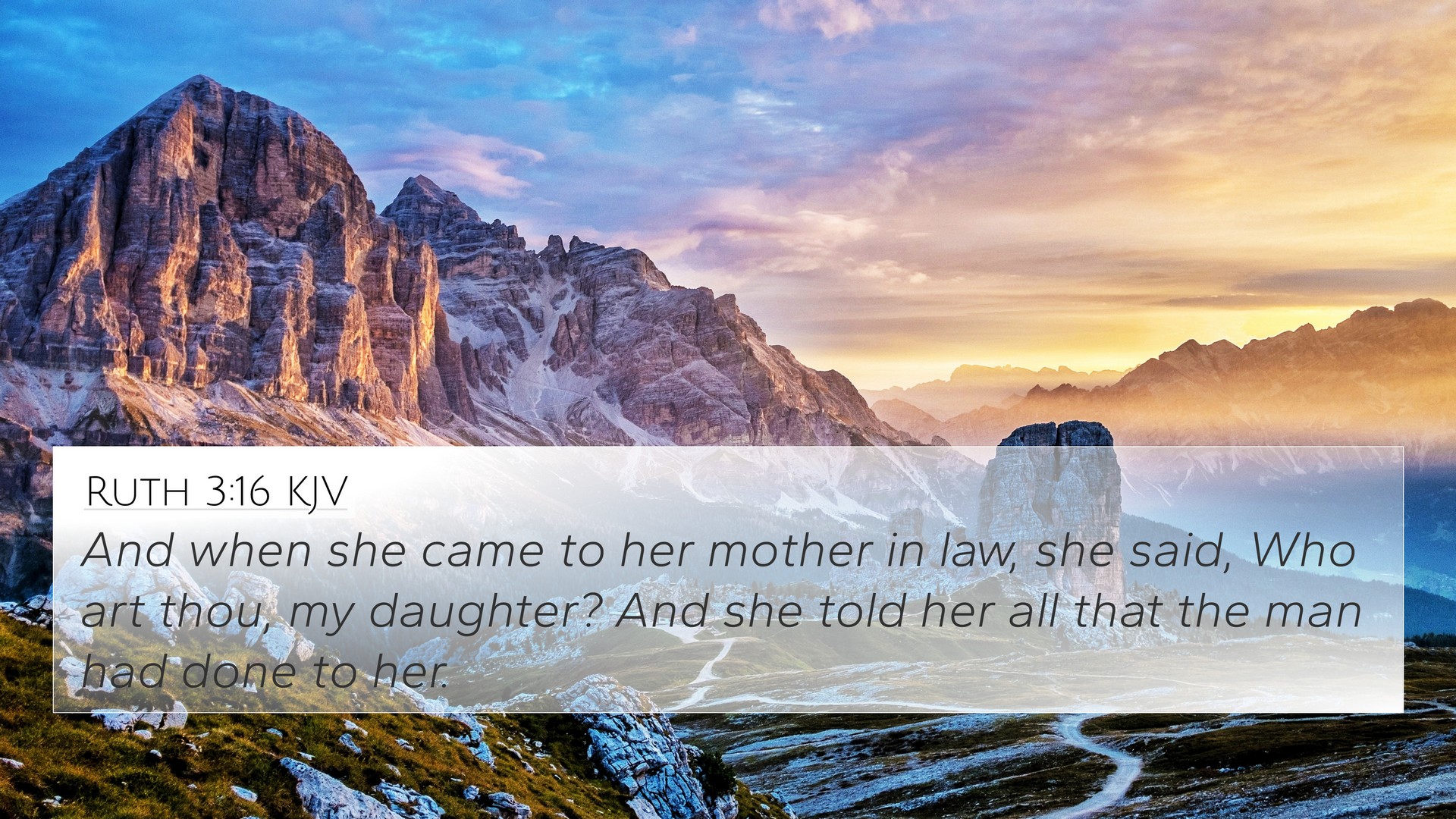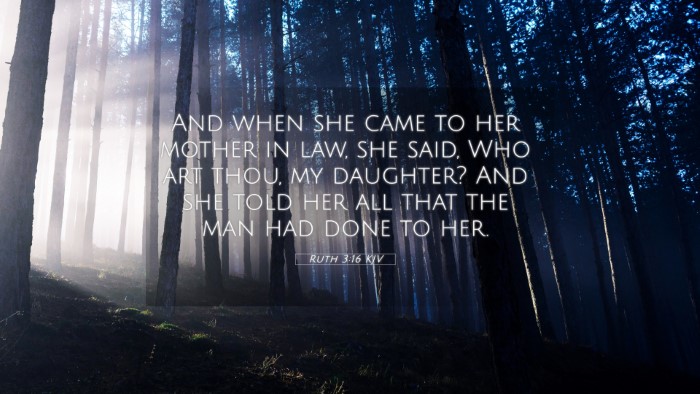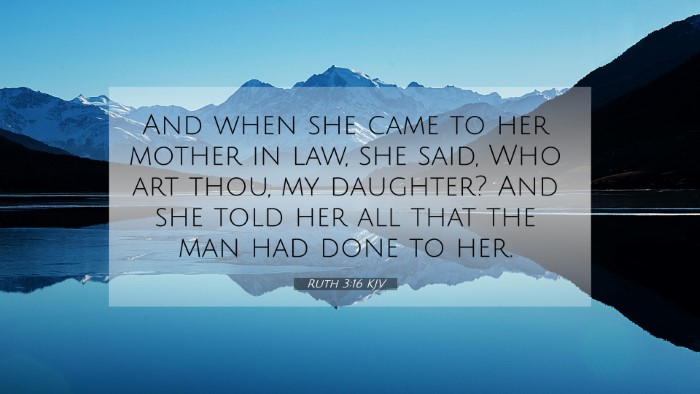Old Testament
Genesis Exodus Leviticus Numbers Deuteronomy Joshua Judges Ruth 1 Samuel 2 Samuel 1 Kings 2 Kings 1 Chronicles 2 Chronicles Ezra Nehemiah Esther Job Psalms Proverbs Ecclesiastes Song of Solomon Isaiah Jeremiah Lamentations Ezekiel Daniel Hosea Joel Amos Obadiah Jonah Micah Nahum Habakkuk Zephaniah Haggai Zechariah MalachiRuth 3:16 Similar Verses
Ruth 3:16 Cross References
And when she came to her mother in law, she said, Who art thou, my daughter? And she told her all that the man had done to her.
Uncover the Rich Themes and Topics of This Bible Verse
Listed below are the Bible themes associated with Ruth 3:16. We invite you to explore each theme to gain deeper insights into the Scriptures.
Ruth 3:16 Cross Reference Verses
No cross reference images were found in our system for this Bible passage.
Ruth 3:16 Verse Analysis and Similar Verses
Bible Verse Interpretation: Ruth 3:16
Verse Text: "And when she came to her mother-in-law, she said, 'Is that you, my daughter?' And she told her all that the man had done for her." (Ruth 3:16)
Summary of Meaning: This verse encapsulates a moment of revelation and communication between Naomi and Ruth after a significant event in Ruth's life. It follows the scene where Ruth, after gleaning in the fields, engages with Boaz on the threshing floor, which is a turning point in the narrative concerning loyalty, family duty, and social customs in ancient Israel.
Insights from Public Domain Commentaries
- Matthew Henry: Henry emphasizes the profound relationship between Ruth and Naomi, showcasing Ruth's loyalty and the importance of familial bonds. He notes that Naomi's inquiry reflects maternal concern and the joys of revelations within family connections.
- Albert Barnes: Barnes details the social implications of Ruth’s encounter with Boaz and how this affects her standing as a Moabite woman in Israel. He highlights that the information Ruth shares with Naomi underscores the merging of their destinies and the providential guidance at play.
- Adam Clarke: Clarke offers insights into the cultural background, connecting this event with the custom of levirate marriage. He explains how Ruth's actions signify her proactive engagement in ensuring her family's lineage and highlights her character strength and determination.
Cross-References to Ruth 3:16
This verse correlates with numerous other biblical texts, deepening understanding through thematic connections:
- Genesis 38:11: Discusses levirate marriage, a theme mirrored in Ruth's actions towards Boaz.
- Deuteronomy 25:5-10: Establishes the law regarding a brother's duty to marry his brother's widow, which is foundational to understanding Ruth's situation.
- 1 Samuel 25:39-44: Illustrates similar themes of women navigating their social landscapes through marriage and familial obligations.
- Matthew 1:5: Mentions Ruth in the genealogy of Jesus, highlighting her significance in biblical history and lineage.
- Luke 16:15: Discusses the value of human relationships in the eyes of God, resonating with Ruth and Naomi’s bond.
- Proverbs 31:10-31: Describes the virtuous woman, traits that certainly align with Ruth's character.
- John 15:12-17: The importance of love and connection among people, paralleling Ruth and Naomi’s relationship.
Thematic Connections
The verse can further be understood in the context of various biblical themes:
- Faithfulness and Loyalty: Ruth's steadfastness to Naomi parallels the loyalty emphasized throughout the Scripture.
- Providence: The unfolding events show God's hand in personal affairs, a recurring biblical theme.
- Rescue and Redemption: The narrative leading to Ruth’s eventual redemption by Boaz foreshadows greater spiritual truths revealed throughout scripture.
- Community and Kinship: Sharing stories, as seen in this verse, builds community ties and emphasizes the importance of familial relationships.
Cross-Referencing in Biblical Studies
This verse is an avenue for cross-referencing biblical texts that illuminate connections across the scriptures:
- Understanding Historical Context: Using tools for Bible cross-referencing enhances comprehension of the cultural backdrop of this passage.
- Thematic Bible Verse Connections: Identifying motifs in the text can lead to deeper insights into God’s character and plans for humanity.
- Comparative Bible Verse Analysis: Analyzing similar events across different texts can highlight variations in God’s objectives and human response.


